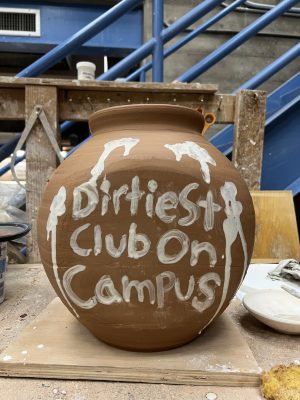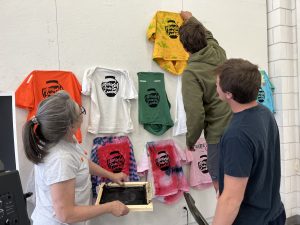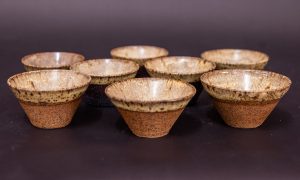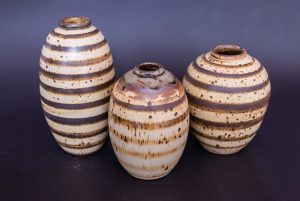By Teddy Doggett, Colorado College Student
 If you have never used handmade pottery, you are probably part of a very small group in your bloodline. Long before humans invented the wheel six-thousand years ago, people began shaping and firing clay to create pottery. Modern day archeologists have found pottery dating back to twenty-eight thousand years ago. Jump ahead several thousand years, and there is a strikingly widespread use of pottery as both functional and decorative across distant cultures. Odds are, your distant ancestors lived in a community that used pottery as vessels for water, food, and valuable materials, often boasting culturally significant artwork. Anthropologist Prudence M. Rice specializes in studying behavior and culture through pottery. In the Journal of Archaeological Method and Theory, Rice prefaces her article by revealing how Anthropologists widely believe that pottery “represents a sophisticated merging of previously separate domains of human knowledge and experience: resources, technological processes, and needs” (Rice, 1999). Today the craft of pottery is far less valued. The brand Mainstay offers a ‘Glazed White Stoneware 12-Ounces Mug’ at Walmart for the incredibly attractive price of $1.12. From a practical standpoint, spending a couple hours to create a mug is beyond senseless. At federal minimum wage, a full work day would earn you enough cash to buy fifty-one Mainstay mugs. Still, countless students at Colorado College spend several hours a week attending Clay Club Open Sessions. Why do students move in herds to the studio instead of working out, studying, partying, or maybe even getting a job—don’t they know about the Walmart mugs?
If you have never used handmade pottery, you are probably part of a very small group in your bloodline. Long before humans invented the wheel six-thousand years ago, people began shaping and firing clay to create pottery. Modern day archeologists have found pottery dating back to twenty-eight thousand years ago. Jump ahead several thousand years, and there is a strikingly widespread use of pottery as both functional and decorative across distant cultures. Odds are, your distant ancestors lived in a community that used pottery as vessels for water, food, and valuable materials, often boasting culturally significant artwork. Anthropologist Prudence M. Rice specializes in studying behavior and culture through pottery. In the Journal of Archaeological Method and Theory, Rice prefaces her article by revealing how Anthropologists widely believe that pottery “represents a sophisticated merging of previously separate domains of human knowledge and experience: resources, technological processes, and needs” (Rice, 1999). Today the craft of pottery is far less valued. The brand Mainstay offers a ‘Glazed White Stoneware 12-Ounces Mug’ at Walmart for the incredibly attractive price of $1.12. From a practical standpoint, spending a couple hours to create a mug is beyond senseless. At federal minimum wage, a full work day would earn you enough cash to buy fifty-one Mainstay mugs. Still, countless students at Colorado College spend several hours a week attending Clay Club Open Sessions. Why do students move in herds to the studio instead of working out, studying, partying, or maybe even getting a job—don’t they know about the Walmart mugs?
Last year, as a freshman at Colorado College, I was looking for ways to engage in the art community and more importantly just make things with my hands. When my photography teacher gave me a key to the darkroom in highschool, I formed an addiction. The darkroom is where I realized that I need to have an artistic obsession—to lose my sense of time creating. When I found it difficult to infiltrate the Colorado College darkroom, I tried out Clay Club Open Sessions. I had done a little bit of ceramics in high school, but I only had the basics down. I was very much still a beginner. Once I went to my first open session I was immediately hooked. Monday, Wednesday, Friday, for two hours after class, I could use as much clay and ask as many questions as I wanted, all for free…with tuition. Within a couple of months I confessed my clay addiction to the studio director Jeremiah, and he began letting me come in for extra hours. By the second semester I was volunteering to help recycle clay, load kilns, and even teach a beginner wheel-throwing class. By the end of my freshman year, the Bemis clay studio was undoubtedly my passion. Jeremiah and the other folks there became mentors not only for my pottery, but for my life. I was recently granted keycard access, and I think it’s safe to say I have the most exposure to the clay studio of any student at Colorado College. My hours spent there are just as important to me as my hours spent doing my curricular coursework. As a Studio Art major with an interest in Anthropology as a minor, spending time talking to good people that have lots of life experience is hands-down my favorite way to learn.
 Unlike myself, most of the Clay Club members aren’t art majors, and do not aspire to be potters; in fact, their actual pottery yield is quite low. Every week the studio is filled with students majoring in Economics, Biology, Philosophy, Anthropology, Physics—you name the major—chances are they’re a Clay Club member. After a few minutes in the studio, it’s evident that students are having lots of fun. Still, there have to be aspects of Clay Club that differ from 3 the dozens of other ‘fun’ activities that Colorado College offers. Pulling from my own experience and conversations with peers at Clay Club, I know that creatively working with your hands offers a calming, therapeutic experience. When consulting Google Scholar, I struggled to find applicable studies on the efficacy of art therapy. Many studies have niche participant groups such as prison inmates, pregnant women, and patients suffering from mental illnesses not commonly found in my research demographic. I was searching for trials on students and eventually came across The effectiveness of art therapy for anxiety in adults: A systematic review of randomised and non-randomised controlled trials. This article spent an incredible amount of time weeding through 776 publications to find three viable random control trials (RCTs) to review in their publication (Abbing et al, 2018). One of these three trials employed the practice of art-making as a tool for handling the anxiety of final exams in undergraduate liberal arts students. Finally I had data collected from a group fitting the demographic of my ethnography. The trial found that “Art making, in a non-verbal, tactile and visual manner, helps entering a flow-like-state of mind that can reduce anxiety, comparable to mindfulness” (Abbing et al, 2018). A second RCT featured in the 2018 article was the Empirical study on the healing nature of mandalas which included students with post-traumatic stress disorder symptoms (Henderson et al, 2007). The study found that “Relative to those in the control condition, individuals assigned to the experimental mandala-creation group reported greater decreases in symptoms of trauma at the 1-month follow up” (Henderson et al, 2007). Whether people consciously designate Clay Club as self-care or not, my preliminary research proves that I can assume the majority of students attending open sessions improve their mental health in some magnitude.
Unlike myself, most of the Clay Club members aren’t art majors, and do not aspire to be potters; in fact, their actual pottery yield is quite low. Every week the studio is filled with students majoring in Economics, Biology, Philosophy, Anthropology, Physics—you name the major—chances are they’re a Clay Club member. After a few minutes in the studio, it’s evident that students are having lots of fun. Still, there have to be aspects of Clay Club that differ from 3 the dozens of other ‘fun’ activities that Colorado College offers. Pulling from my own experience and conversations with peers at Clay Club, I know that creatively working with your hands offers a calming, therapeutic experience. When consulting Google Scholar, I struggled to find applicable studies on the efficacy of art therapy. Many studies have niche participant groups such as prison inmates, pregnant women, and patients suffering from mental illnesses not commonly found in my research demographic. I was searching for trials on students and eventually came across The effectiveness of art therapy for anxiety in adults: A systematic review of randomised and non-randomised controlled trials. This article spent an incredible amount of time weeding through 776 publications to find three viable random control trials (RCTs) to review in their publication (Abbing et al, 2018). One of these three trials employed the practice of art-making as a tool for handling the anxiety of final exams in undergraduate liberal arts students. Finally I had data collected from a group fitting the demographic of my ethnography. The trial found that “Art making, in a non-verbal, tactile and visual manner, helps entering a flow-like-state of mind that can reduce anxiety, comparable to mindfulness” (Abbing et al, 2018). A second RCT featured in the 2018 article was the Empirical study on the healing nature of mandalas which included students with post-traumatic stress disorder symptoms (Henderson et al, 2007). The study found that “Relative to those in the control condition, individuals assigned to the experimental mandala-creation group reported greater decreases in symptoms of trauma at the 1-month follow up” (Henderson et al, 2007). Whether people consciously designate Clay Club as self-care or not, my preliminary research proves that I can assume the majority of students attending open sessions improve their mental health in some magnitude.
 With a little research under my belt, it was time to get into the field and do some participant observation. I arrived at the studio before any Clay Club members were there. The 4 studio always has the same smell, same look, same lighting, and same sounds of pipes breathing. But as soon as people began to arrive, the studio felt different than I’d been accustomed to as an artist. Today I was an observer, and suddenly the studio felt more animated. Between 12:55 and 1:05, there is beautiful “dance,” as Jeremiah poetically describes, in the Bemis clay studio. Roughly sixty students filter down a small staircase and pack the space. While the studio is made up of three large rooms, most of the floor space is filled by wheels, tables, stools, 5-gallon buckets, and shelves. Sixty post-lunch fueled students hecticly pace their way through tight single-person galleys. In a conversation with Jeremiah, I pointed out that people move faster in the clay studio than spaces like the sidewalk. Jeremiah responded with a very playful “Yeah…but you see the new people come in, and all you can think is why do you keep bumping into people, that’s so not helpful,” following with the truth about the “beautiful” way that newcomers so quickly become a part of the “choreographed dance” that is clay club.
With a little research under my belt, it was time to get into the field and do some participant observation. I arrived at the studio before any Clay Club members were there. The 4 studio always has the same smell, same look, same lighting, and same sounds of pipes breathing. But as soon as people began to arrive, the studio felt different than I’d been accustomed to as an artist. Today I was an observer, and suddenly the studio felt more animated. Between 12:55 and 1:05, there is beautiful “dance,” as Jeremiah poetically describes, in the Bemis clay studio. Roughly sixty students filter down a small staircase and pack the space. While the studio is made up of three large rooms, most of the floor space is filled by wheels, tables, stools, 5-gallon buckets, and shelves. Sixty post-lunch fueled students hecticly pace their way through tight single-person galleys. In a conversation with Jeremiah, I pointed out that people move faster in the clay studio than spaces like the sidewalk. Jeremiah responded with a very playful “Yeah…but you see the new people come in, and all you can think is why do you keep bumping into people, that’s so not helpful,” following with the truth about the “beautiful” way that newcomers so quickly become a part of the “choreographed dance” that is clay club.
The studio consists of a wheel-throwing room fitting seventeen wheels, a handbuilding room containing a table for roughly twenty people, and a third hybrid-room with five wheels, plus several tables allowing for another dozen or-so handbuilders. This geographical aspect of Clay Club offers notable diversity in objectives, behavior, and outcomes for individuals. I’ve spent most of my time in the larger wheel-throwing room, and when I really began observing the two dozen folks at the handbuilding table, I was shocked. As I sat atop a shelf betwixt the two rooms, the hand builders’ separate senses of touch and sight caught my eye. Many of them would rest their hands on the table pinching small bowls, cups, or figurines, while simultaneously maintaining eye contact and full conversations with their peers. These individuals would frequently squish their work and start again and again. For most people working on the wheels, this is unthinkable. The wheel moves at such a fast pace that throwers must be focusing on their movements with touch, sight, and even sound.1 As I got to talking with those who spend their time at the large table, they told me that it gives them a chance to spend time with new people and escape the repetition of social cliques. A couple even confided that it relieved some of their loneliness just to be in the space with others. While not all of the students working at the handbuilding table seek company or show such outgoing behavior, it’s clear that this particular room attracts those that are looking for a social setting, promoting positive social health.
 As I turned my attention 180 degrees to the left facing the wheel-throwers, my existing conceptions of the space were deepened. At half of the seventeen wheels students wore headphones, and of the un-headphoned half, only a handful engaged in any notable conversation. It’s not as if you’d walk up to one of these potters and get the silent treatment; they’re happy to talk to you, but their wheel is a personal creative space. They find music and or a lack of talking as the best way to stay locked-in. Within this recurring group of throwers, there is a wide variety of skill levels, but as I questioned both the experienced and beginner students, they shared very similar responses: most commonly, Clay Club is a time where they can truly focus on a healthy obsession. Many of them remarked that they use the time to escape their digital life. Dirty wet clay hands mean less phone use. Additionally, I wasn’t surprised when one student admitted “I used to go to my room after class every day and rip bong, now I do this.” So many of these students seem to be more focused on the wheel than when I see them working on homework in the library. How could someone care so much about a chunk of dirt spinning in circles? For wheel throwers especially, Jeremiah points out that “It gives them something to take with them. You guys write these papers, do these exams, and oftentimes you never look at them again. At Clay Club, you can drink water out of something you made with your hands.” While Jeremiah recognizes that the majority of students value coursework in their area of study more than making a pot, he explains that most of us simply couldn’t make it through our rigorous schedules without having joy in the short term. Perhaps Clay Club is just as valuable as your curricular class if you couldn’t keep showing up and studying without that creative outlet.
As I turned my attention 180 degrees to the left facing the wheel-throwers, my existing conceptions of the space were deepened. At half of the seventeen wheels students wore headphones, and of the un-headphoned half, only a handful engaged in any notable conversation. It’s not as if you’d walk up to one of these potters and get the silent treatment; they’re happy to talk to you, but their wheel is a personal creative space. They find music and or a lack of talking as the best way to stay locked-in. Within this recurring group of throwers, there is a wide variety of skill levels, but as I questioned both the experienced and beginner students, they shared very similar responses: most commonly, Clay Club is a time where they can truly focus on a healthy obsession. Many of them remarked that they use the time to escape their digital life. Dirty wet clay hands mean less phone use. Additionally, I wasn’t surprised when one student admitted “I used to go to my room after class every day and rip bong, now I do this.” So many of these students seem to be more focused on the wheel than when I see them working on homework in the library. How could someone care so much about a chunk of dirt spinning in circles? For wheel throwers especially, Jeremiah points out that “It gives them something to take with them. You guys write these papers, do these exams, and oftentimes you never look at them again. At Clay Club, you can drink water out of something you made with your hands.” While Jeremiah recognizes that the majority of students value coursework in their area of study more than making a pot, he explains that most of us simply couldn’t make it through our rigorous schedules without having joy in the short term. Perhaps Clay Club is just as valuable as your curricular class if you couldn’t keep showing up and studying without that creative outlet.
I wanted to return to the idea that making pottery is a senseless act. Admittedly, I borrowed this idea of ‘senselessness’ from anthropologist Dimitris Xygalatas. I’ve never seen pottery as a senseless act, and at this point in my paper, I hope that you don’t either. Working with clay grounds the group of Colorado College students that call themselves potters. It helps to justify the sky high $70,244 tuition, and if not that, the four years of their life they’re spending here. More and more recently, the need for higher education is being challenged, and the question we students often ask ourselves reminds me of the existential question that humans have been asking for millenia: why are we here? After watching Xygalatas’s TedxAthens talk, ‘The Power of Ritual’ for my Anthropology class, I began thinking of Clay Club as a ritual. While my Anthropology class defines ritual as “the symbolic expression of sentiments,” Xygalatas points out that there doesn’t need to be much conscious thought: “When we [perform a ritual], we do it because, well, we just do it” (Hautzinger 2024) & (Xygalatas 2016). Ironically, I wanted to know why we, Clay Club members, spend our time there. For the most part, that’s beside the point, we just do it because we do it. Finding ways to express ourselves through repeated actions is only human, “from the first time our ancestors gathered around the fire to perform their rituals, whether consciously or unconsciously, we have learned to harness the power of ritual” (Xygalatas 2016).
Students at Colorado College chose to make Clay Club their six-hour a week ritual because the space, the people, and the action fits their needs of expression, the same way that attending to a repetitive sports schedule meets others’ needs of expression. These students are predominantly working tirelessly to become biologists, economists, astronomers, philosophers—not potters or professional soccer players. While it may seem senseless to spend one hundred hours a semester making mugs if your dream is to be the next chief editor of the New York Times, this creative ritual is what keeps us potters human.
1. How does one use sound to throw a pot, you might ask? Well, on any of the wheels other than the VL-Whisper Lights in the Bemis studio, the brushless motor exudes a telling whine that communicates RPMs to experienced potters.
Work Cited
Abbing A, Ponstein A, van Hooren S, de Sonneville L, Swaab H, Baars E (2018) “The effectiveness of art therapy for anxiety in adults: A systematic review of randomised and non-randomised controlled trials.” PLoS ONE 13(12): e0208716. https://doi.org/10.1371/journal.pone.0208716. Accessed 16 September. 2024.
Henderson P, Rosen D, Mascaro N. “Empirical study on the healing nature of mandalas” Psychology of Aesthetics, Creativity, and the Arts. 2007;1(3):148–54. Accessed 16 September. 2024
Hautzinger, Sarah: “Symbols, Social Organization, and Spirit” Anthropology 102. 10 September, 2024. Colorado College. Lecture.
Rice, Prudence M. “On the Origins of Pottery.” Journal of Archaeological Method and Theory, vol. 6, no. 1, 1999, pp. 1–54. JSTOR, http://www.jstor.org/stable/20177395. Accessed 17 September. 2024.
“The Power of Ritual.” YouTube, uploaded by Dimitris Xygalatas & TedxAthens, 1 Apr. 2016, www.youtube.com/watch?v=IrjCLvSQ_cw. Accessed 15 September. 2024.


